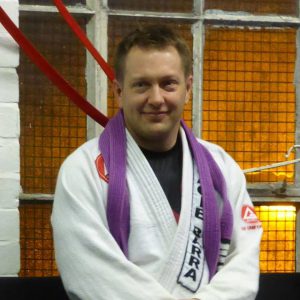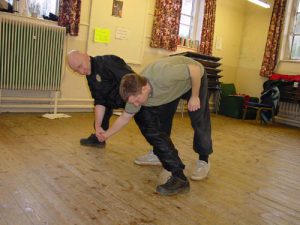One of my goals with Qialance is to connect with other Taijiquan and Qi Gong enthusiasts around the world. And I like blogging. Obviously I had to create a list of the Top 15 Tai Chi Blogs!
But I want to go further and learn more about those bloggers. So I hope you are just as curious as I am because I interview them. And this is the talk with Graham Barlow from The Tai Chi Notebook:
Could you please tell a bit more about yourself?
Sure – I’m married with two kids and work a regular job, so martial arts is my hobby, not my full-time occupation. I started Tai Chi back in 1993, and despite moving around the country and having different teachers I have practiced pretty much consistently since then. In 2000 I found the man I consider my “Tai Chi teacher”. In 2011, at 39 years old, I also discovered Brazilian Jiujitsu (BJJ) and decided to give it a go. I haven’t looked back. I started my blog The Tai Chi Notebook a couple of years ago.
Which style are you into and why?
In terms of Tai Chi, the style I started with in 1993 was an interesting variation of the Yang style. I’ve tried various Tai Chi styles since, but have always come back to this. It could be because of loyalty to my first style, but I also think that it’s the most efficient form I know for embodying the principles of Tai Chi Chuan. It’s good for health, but it’s also good for fighting. Whatever the reason I keep coming back to it.
Our style was introduced to the UK from Hong Kong in the 1970s by Master Lam Kam Chuen, so it is sometimes referred to as “Lam Tai Chi”, since Master Lam created his own short form. I did a bit of research on the Internet and found that our style had spread to the US also, where it is called Ku/Gu Style Tai Chi, after the famous Ku Yu Chang/Gu Ruzhang (the King of Iron Palm) who was one of Master Lam’s teachers.
The style is essentially a Yang style, coming from Yang Chien-Hou, so it’s medium frame. It seems to have had lots of influences along the way, including input from Li Jing-Lin, Sun Lu Tang and Ku Yu Chang.
It’s interesting, that you always go back to your first form. Because I feel the same about “my” first form!
What is the biggest benefit you get from your practice?
Outside of training I don’t get into fights on a regular basis! So, I’d have to say the biggest benefit of Tai Chi practice for me is simply that it makes me feel good. In BJJ there’s a lot of stress on the joints, so Tai Chi helps keep them strong and mobile and recover well. I also really enjoy the mental sense of peacefulness and quiet that a solo practice of Tai Chi can give you. It brings you back to yourself.
Well, I am glad that you don’t get into fights outside of training! I also do Tai Chi to feel good. However the martial arts aspect is a very intriguing part I would not want to miss.
Which piece of advice would you give a beginner in Taijiquan?
Practice every day. It’s easy to fall into the trap of intellectualising Tai Chi Chuan, but really it’s a physical practice – you need to saturate your body in it so much that it just becomes the way you move. The only way to do this is sheer weight of practice.
Oh, I like that you emphasize the importance of practicing daily. I know so many people struggle with it, but it is really so important.
Who are or were your most important teachers?
Sifu Raymond Rand – my Tai Chi teacher. Very open and generous with his knowledge and he genuinely loves any opportunity for a good spar, especially with poles. (Never pick up a pole when he is around!) He was trained in all aspects of Tai Chi Chuan, so he has a very deep knowlege on Tai Chi and all related subjects.
Sifu Damon Smith – my XingYi teacher. Damon taught me his style of XingYi for around 2001. Very different to Tai Chi as a fighting style, but also very subtle. His use of footwork is especially skillful. Damon is also a high level practitioner of various Japanese arts, but I was only ever interested in his XingYi, which featured a lot of emphasis on the 12 Animals and weapons. His particular favourite was Tiger, which reflected his character perfectly!
Professor Salvatore Pace (Salvo) – looking for a new challenge, and feeling a bit out of shape as I approached my 40th birthday I tried out a Brazilian Jiujitsu class. I loved it straight away. I felt it offered a new way to apply the soft strategy of Tai Chi in a fully-resisting sparring environment, but what really kept me there was Salvo’s teaching and the great example of how to be a leader and a martial artist that he sets. His understanding of how to apply leverage and pressure on the ground was a revelation to me. He brings a lot of integrity to the teaching as well – he says regularly that he only teaches moves he actually uses himself when sparring. In BJJ I discovered a really healthy outlet for the natural human need for a playful physical exchange. I think BJJ has a lot to offer as a martial art for everybody.
Is there any teacher or master you would like to learn from in the near future?
Mike Sigman. I’m hoping to meet Mike this year when he’s over in the UK. Coming from an engineering background, Mike has been trying to work out what the core component of Chinese arts like Tai Chi and XingYi is for years now in a way that Westerners can understand. He calls this common factor “6H movement”. I’ve found his insights into Tai Chi to be revolutionary. Nothing he has come up with contradicts what I’ve been taught, he’s just coming at it from a different place and producing a unified theory of everything. I think his ideas have helped me become a better all-round practitioner, enabling me to fill in missing gaps in my knowledge, or get a better perspective on things I only partially understood. In the traditional martial arts so much of the knowledge is transmitted by touch, rather than by explanation, that it can be easy to misunderstand (I think that, in a way, this is why you get so many different styles emerging).
Marcelo Garcia. When it comes to BJJ, it’s widely acknowledged that Marcelo Garcia is one of the all-time greats. I’d love to attend a class or seminar of his one day. I have a similar body type to Marcelo, so I find that his techniques work well for me – the Butterfly guard, Single X, the X-Guard, for example. One of his students, Josh Waltzkin (the Chess prodigy) also trains Tai Chi, and sees a connection between BJJ and Tai Chi, like I do.
Oh, recently I heard a lot about Mike Sigman. He is someone I would like to learn from, too!
Is there a book you recommend? One you often like to pick up and refer to?
Tai Chi Chuan: A comprehensive training manual – Raymond Rand*
Mind, Body and Sprit: Complete Health and Well-being with Tai Chi – Donald Kerr*
Thank you, Graham, for the interview and for sharing your Tai Chi & BJJ story.
If you want to read more from Graham, visit his blog The Tai Chi Notebook!
Happy Qi!
Angelika



Pingback: Top 20 martial arts blogs 2017 | The Tai Chi Notebook
Pingback: 15 Top Tai Chi blogs (and how to read them easily)